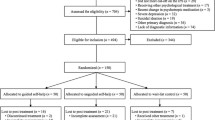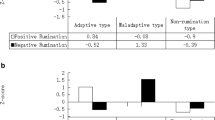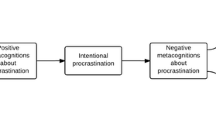Abstract
Lay's (1986) General Procrastination (GP) and McCown and Johnson's (1989) Adult Inventory for Procrastination (AIP) measures were evaluated across two studies. In Study 1, both inventories were administered to two groups of college students (Sample 1 n=52; Sample 2 n=59), who were asked to return completed scales before the end of the semester. Students' attendance rates at study groups, test grades, and time required to complete multiple choice items on two exams also were recorded. Results indicated that high procrastination scores were related to a higher number of days to return completed inventories but not attendance, exams scores, or test-taking time. In Study 2, nontraditional age university students (n=215) were asked to complete procrastination measures as well as sensation-seeking, need for cognition, and self-esteem inventories. Factor analysis indicated that scores on Lay's (1986) scale loaded on sensation-seeking, while McCown and Johnson's (1989) scale loaded negatively with need for cognition and self-esteem variables. It would appear that although the scales assessed procrastinatory behavior, one inventory is indicative of sensation-seeking and the other the avoidance of poor self-esteem.
Similar content being viewed by others
References
Bem, D. J. (1972). Self-perception theory. In L. Berkowitz (Ed.),Advances in experimental social psychology (Vol. 6). New York: Academic Press.
Beswick, G., Rothblum, E. D., & Mann, L. (1988). Psychological antecedents to students' procrastination.Australian Psychologist, 23, 207–217.
Burka, J. B., & Yuen, L. M. (1983).Procrastination: Why you do it and what to do about it. Reading, PA: Addison-Wesley.
Cacioppo, J. T., & Petty, R. E. (1982). The need for cognition.Journal of Personality and Social Psychology, 42, 116–131.
Cacioppo, J. T., Petty, R. E., Kao, C. F., & Morris, K. J. (1983). Effects of need for cognition on message evaluation, recall, and persuasion.Journal of Personality and Social Psychology, 45, 805–818.
Cacioppo, J. T., Petty, R. E., & Kao, C. F. (1984). The efficient assessment of need for cognition.Journal of Personality Assessment, 48, 306–307.
Cacioppo, J. T., Petty, R. E., Kao, C. F., & Rodriguez, R. (1986). Central and peripheral routes to persuasion: An individual difference perspective.Journal of Personality and Social Psychology, 51, 1032–1043.
Carol, E. N., Zuckerman, M., & Vogel, W. H. (1982). A test of the optimal level of arousal theory of sensation seeking.Journal of Personality and Social Psychology, 42, 572–575.
Effert, B., & Ferrari, J. R. (1989). Decisional procrastination: Examining personality correlates.Journal of Social Behavior and Personality, 4, 151–156.
Ellis, A., & Knaus, W. J. (1977).Overcoming procrastination. New York: Signet Books.
Ferrari, J. R. (1989a).Academic and dispositional procrastination: Examining personality correlates. Paper presented at the annual meeting of the Eastern Psychological Association, Boston, MA.
Ferrari, J. R. (1989b). Reliability of academic and dispositional measures of procrastination.Psychological Reports, 64, 1057–1058.
Ferrari, J. R. (1991a). Compulsive procrastination: Some self-reported characteristics.Psychological Reports, 68, 455–458.
Ferrari, J. R. (1991b). Self-handicapping by procrastinators: Protecting self-esteem, social-esteem, or both?Journal of Research in Personality, 25, 245–261.
Ferrari, J. R. (1991c). A preference for a favorable public impression by procrastinators: Selecting among cognitive and social tasks.Personality and Individual Differences, 12, 1233–1237.
Ferrari, J. R. (1991d). Procrastination and project creation: Choosing easy, nondiagnostic items to avoid self-relevant information.Journal of Social Behavior and Personality, 6, 619–628.
Ferrari, J. R. (1992a). Procrastination and perfect behavior: An exploratory factor analysis of self-presentation, self-awareness, and self-handicapping components.Journal of Research in Personality, 26, 75–84.
Ferrari, J. R. (1992b). Procrastination in the workplace: Attributions for failure among individuals with similar behavioral tendencies.Personality and Individual Difference, 13, 315–319.
Heppner, P. P., Reeder, B. L., & Larson, L. M. (1983). Cognitive variables associated with personal problem-solving appraisal-implications for counseling.Journal of Counseling Psychology, 30, 537–545.
Horvath, P. M., & Zuckerman, M. (1990).Risk appraisal, risk taking, and sensation-seeking: Comparing AIDS risks vs. general risks. Paper presented at the annual meeting of the Eastern Psychological Association, Philadelphia, PA.
Johnson, J., & McCown, W. (1990).Anxiety gradients in typologies of procrastination. Unpublished manuscript, Department of Mental Health Services/Psychology, Hahnemann University, Philadelphia, PA.
Kohn, P. M., Barnes, G. E., & Hoffman, F. M. (1979). Drug-use history and experience seeking among adult male correctional inmates.Journal of Consulting and Clinical Psychology, 47, 708–715.
Larwood, R. A. (1990). Procrastinators behave: Someone is watching you.Syracuse Post-Standard, Nov., p. 5.
Lay, C. H. (1986). At last, my research in procrastination.Journal of Research in Personality, 20, 479–495.
Lay, C. H. (1987). A modal profile analysis of procrastinators: A search for types.Personality and Individual Differences, 8, 705–714.
Lay, C. H. (1988). The relationship of procrastination and optimism to judgments of time to complete an essay and anticipation of setbacks.Journal of Social Behavior and Personality, 3, 201–214.
Lay, C. H. (1990). Working to schedule on personal projects: An assessment of person-project characteristics and trait procrastination.Journal of Social Behavior and Personality, 5, 91–104.
Malatesta, M., Sutker, P. B., & Treiber, F. A. (1981). Sensation seeking and chronic public drunkenness.Journal of Consulting and Clinical Psychology, 49, 292–294.
McCown, W., & Johnson, J. (1989).Validation of an adult inventory of procrastination. Unpublished manuscript, Department of Mental Health/Psychology, Hahnemann University, Philadelphia, PA.
McCown, W., Johnson, J., & Petzel, T. (1989). Procrastination, a principal component analysis.Personality and Individual Differences, 10, 197–202.
McCown, W., Johnson, J., & Carise, D. (1991). Trait procrastination in self-described adult children of excessive drinkers: An exploratory study.Journal of Social Behavior and Personality, 6, 147–151.
Olson, K., Camp, C., & Fuller, D. (1984). Curiosity and need for cognition.Psychological Reports, 54, 71–74.
Rosenberg, M. J. (1979).Conceiving the self. New York: Basic Books.
Solomon, L. J., & Rothblum, E. D. (1984). Academic procrastination: Frequency and cognitive-behavioral correlates.Journal of Counseling Psychology, 31, 503–509.
Tanaka, J. S., Panter, A. T., & Winborne, W. C. (1988). Dimensions of the need for cognition: Subscales and gender differences.Multivariate Behavioral Research, 23, 35–50.
Zuckerman, M., Eysenck, S., & Eysenck, H. J. (1978). Sensation-seeking in England and America: Cross-cultural, age, and sex comparisons.Journal of Consulting and Clinical Psychology, 46, 139–149.
Zuckerman, M., Buchsbaum, M. S., & Murphy, D. L. (1980). Sensation-seeking and its biological correlates.Psychological Bulletin, 88, 187–214.
Author information
Authors and Affiliations
Additional information
Data for Study 1/Sample 1 and Study 2 were collected when the author was a Visiting Assistant Professor at Baruch College/CUNY. The author thanks instructors for permitting class time to be devoted to the data collection process. Also, the author thanks Bill McCown and Clarry Lay for editing an early draft of this paper.
Rights and permissions
About this article
Cite this article
Ferrari, J.R. Psychometric validation of two Procrastination inventories for adults: Arousal and avoidance measures. J Psychopathol Behav Assess 14, 97–110 (1992). https://doi.org/10.1007/BF00965170
Accepted:
Issue Date:
DOI: https://doi.org/10.1007/BF00965170




